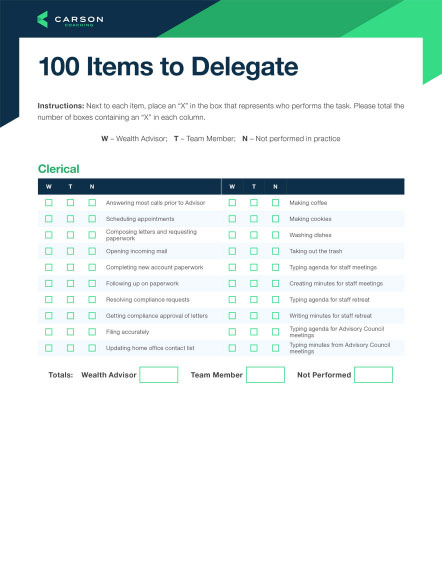We’ve all experienced it in this profession – new technologies rise, investment strategies shift, stakeholders come and go. It’s inevitable: Change happens. Communicating those changes can be the difference between clients being excited for the future or anxious to find a new advisor. The key is understanding how and when to inform the households you serve about the changes taking place.
Effectively communicating change happens in five steps. I call these the the five M’s of change communications: medium, message, moment, move and measure. Each step should be outlined in a communications plan before you begin, including the goal of the message, the intended audience, the dates when you’ll send the message, and the anticipated challenges you expect to face.
1. Choose the Right Medium
It all starts with understanding your audience, then delivering a message tailored to that audience. If your clients are mostly business executives who use technology daily, then you may want to use email or video to explain the changes. If you mostly work with retired or nearly retired individuals who don’t have smartphones or regularly check email, then you may want to write a letter or hold an in-person client event.
The medium can also depend on the changes being made. For example, if you’re rolling out a new client dashboard or unveiling your new brand, then it’d be beneficial to use a medium that includes lots of visuals, like video or email. On the other hand, if the changes are complicated investment strategies or detailed merger or succession information, you may want to use a medium that allows you to provide a simplified overview along with frequently asked questions, then also have an in-person presentation to better put the changes in layman’s terms.
Don’t be afraid to mix and match your mediums. You can send a letter and also put a video on social media. You can email your clients the information then follow up with an in-person presentation. If your firm is small enough, you could even personally call every client.
2. Properly Frame the Message
Once you’ve chosen the communications vehicle, it’s time to install the engine. When crafting your message, you’re not just communicating a change – you’re explaining why a change is happening and outlining everything your clients will need to do as part of the process. Your message should always revolve around one point: how the change affects your clients. Even in situations of bad news, keep your clients at the center of your message.
- “The reason we are making this change is to better serve you.”
- “We are on a mission to stay on the leading edge to better help you, and this change allows us to do that.”
- “We are looking to supplement and improve our service offering by making this change.”
By keeping your clients at the center and explaining how the change improves your services for them. Your audience will be much more understanding if various hurdles pop up along the way.
3. Deliver at the Right Moment
Now that you’ve crafted your message and you know how it will be delivered, you’ll now need to determine when to send it. This will vary widely depending on the type of change being communicated. However, there are two very obvious yet important rules to follow:
- Don’t send too early.
- Don’t send too late.
See? Told you they were obvious. But they are also very important. If you’re implementing a new piece of technology, telling your clients while the change is still a year out is probably not the best idea. That’s because you need a firm idea of when the changes will actually happen, what the client will need to do on their part, and to have answers to questions beyond “we’ll cross that bridge when we come to it.” On top of that, you could end up changing your mind or finding a better solution within the next year.
On the other hand, if you wait too long before communicating a change, you’ll be left with clients who feel surprised and overwhelmed. If you implement that new technology with no warning, clients will be scrambling to learn and have no time to take care of any needed actions on their part, like setting up new account credentials or taking a tutorial. A good rule of thumb is to list out the 10 questions you believe clients will ask most often. If you don’t have answers to those questions, you probably shouldn’t communicate the change yet.
Related content: Are You Asking Your Top Clients the Right Questions?
4. Support Throughout the Move
OK, you’ve delivered the message and addressed any hurdles that came up along the way. Now you’re in full support mode. Transitions are never easy, but they can also be exciting. You want to sell that excitement as you support your clients going forward. Provide a phone number or email address where clients can turn for assistance, and make sure your team is aware of your support process before you communicate the change.
You may have some frustrated clients, so put together talking points and train your team on how to deal with each situation before you implement anything new. Always remember that it’s OK to continue communications throughout the transition. For example, if you roll out a new website and important client links are unexpectedly broken, you should apologize and address it before your clients become upset. Honesty and transparency are key to any change communications plan.
5. Measure the Results
Finally, you’re ready to step back and analyze the results of your communications plan. You may want to do a client satisfaction survey or discuss the change process in upcoming client meetings to get a better feel for how everyone handled the adjustment. Internally, you should answer these five questions, solve any issues that pop up, and repeat until all known problems are resolved.
- Is there anything still causing trouble for my clients?
- What percentage of my clients struggled with this change and why?
- What was the biggest sticking point for my clients?
- What additional communications are needed to complete this process?
- How can I improve this process next time?
When done effectively, change communications will create excitement for the future – for your team and your clients. And with the measured results and feedback you’ve received along the way, you’ll be more than ready to communicate the next big improvement coming from your firm.


